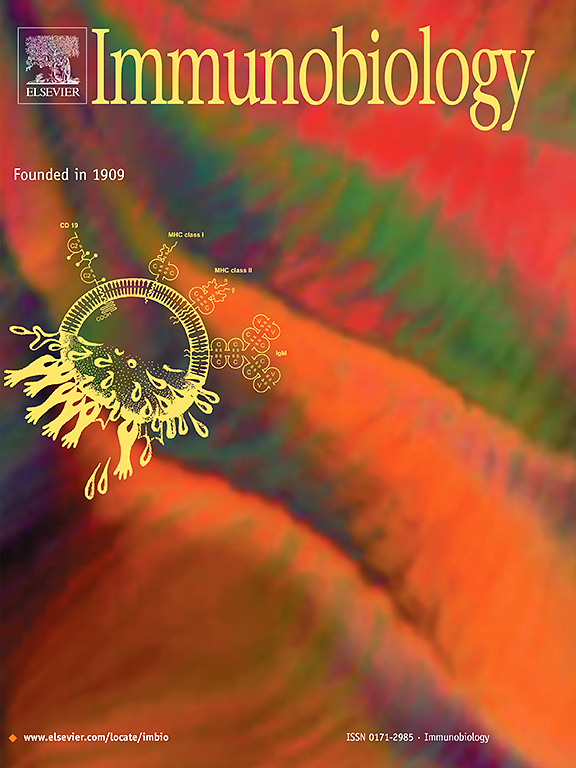Investigation of the HLA locus in autopsy-confirmed progressive supranuclear palsy
IF 2.3
4区 医学
Q3 IMMUNOLOGY
引用次数: 0
Abstract
Objectives
Progressive supranuclear palsy (PSP) is a neurodegenerative disease showing pathological tau accumulation in subcortical neurons and glial cells. The human leukocyte antigen (HLA) locus on chromosome 6 is a polymorphic region with complex linkage patterns that has been implicated in several autoimmune and neurological disorders. The HLA locus has not been systematically examined in PSP. It is unclear whether tau and HLA can interact to induce an autoimmune disease mechanism.
Methods
We evaluated an autopsy confirmed PSP cohort (n = 44) and compared allele/haplotype frequencies to those of the reference group of a local deceased Canadian donor pool. We performed HLA-Tau peptide binding prediction and modelling of HLA Class II – Tau Peptide interactions.
Findings
Odds ratio was 2.94 (95 % CI 1.01 to 8.55; p = 0.047) for DQB1*06:01 allele, and 2.59 (95 % CI 1.39 to 4.83; p = 0.0025) for the narcolepsy-associated haplotype (DRB1*15:01-DQB1*06:02). One patient with 4-repeat tau PSP-type pathology was a carrier of the IgLON5-associated haplotype (DRB1*10:01-DQB1*05:01). HLA-Tau peptide binding prediction and modelling of HLA Class II – Tau Peptide interactions revealed strong-binding tau peptides but not the PSP-protofilament fold for alleles DQA1*01:02-DQB1*06:02 and DQA1*01:03-DQB1*06:01.
Conclusion
Our study suggests that epitopes within the tau peptide may bind to HLA alleles that are found in a subset of PSP patients supporting the notion of an autoimmune pathophysiological component. These findings have implications for subtyping and stratifying patients for therapies, including those targeting immune modulation.

尸检证实的进行性核上性麻痹患者HLA位点的研究
目的进行性核上性麻痹(PSP)是一种神经退行性疾病,表现为皮层下神经元和神经胶质细胞的病理性tau积聚。6号染色体上的人类白细胞抗原(HLA)位点是一个具有复杂连锁模式的多态区域,与多种自身免疫性和神经系统疾病有关。在PSP中,HLA位点尚未被系统地检测。目前尚不清楚tau和HLA是否可以相互作用诱导自身免疫性疾病的机制。方法:我们评估了尸检证实的PSP队列(n = 44),并将等位基因/单倍型频率与当地已故加拿大供体池的参考组进行了比较。我们进行了HLA-Tau肽结合预测和HLA II类-Tau肽相互作用的建模。发现sods比值为2.94 (95% CI 1.01 ~ 8.55;DQB1*06:01等位基因p = 0.047), 2.59 (95% CI 1.39 ~ 4.83;p = 0.0025)为嗜睡相关单倍型(DRB1*15:01-DQB1*06:02)。1例4重复tau psp型病理患者携带iglon5相关单倍型(DRB1*10:01-DQB1*05:01)。HLA-Tau肽结合预测和HLA II类-Tau肽相互作用模型显示,DQA1*01:02-DQB1*06:02和DQA1*01:03-DQB1*06:01等位基因具有强结合的Tau肽,但不具有psp -原丝折叠。结论:我们的研究表明,tau肽内的表位可能与在PSP患者亚群中发现的HLA等位基因结合,支持自身免疫病理生理成分的概念。这些发现对治疗亚型和患者分层具有启示意义,包括针对免疫调节的治疗。
本文章由计算机程序翻译,如有差异,请以英文原文为准。
求助全文
约1分钟内获得全文
求助全文
来源期刊

Immunobiology
医学-免疫学
CiteScore
5.00
自引率
3.60%
发文量
108
审稿时长
55 days
期刊介绍:
Immunobiology is a peer-reviewed journal that publishes highly innovative research approaches for a wide range of immunological subjects, including
• Innate Immunity,
• Adaptive Immunity,
• Complement Biology,
• Macrophage and Dendritic Cell Biology,
• Parasite Immunology,
• Tumour Immunology,
• Clinical Immunology,
• Immunogenetics,
• Immunotherapy and
• Immunopathology of infectious, allergic and autoimmune disease.
 求助内容:
求助内容: 应助结果提醒方式:
应助结果提醒方式:


